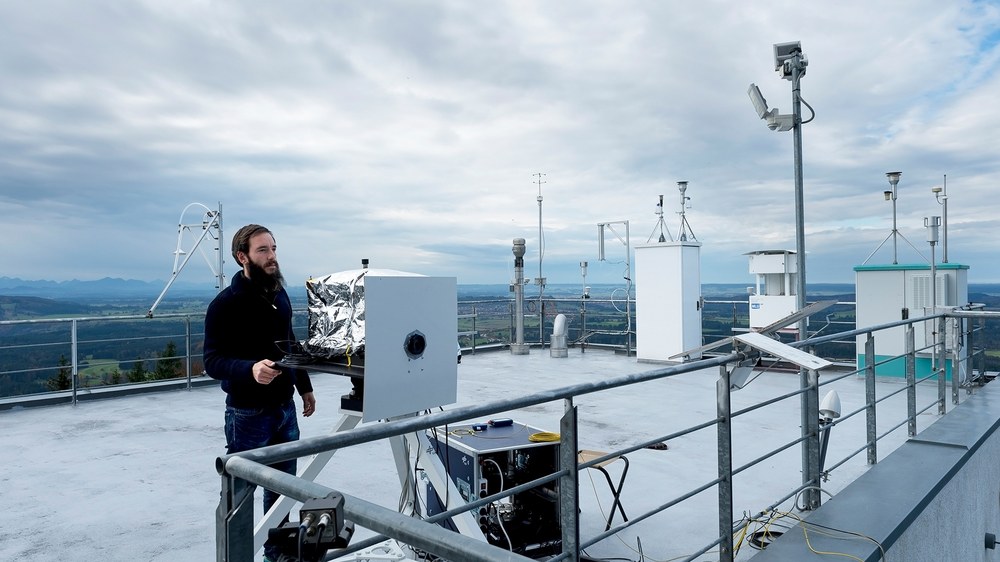Optical Technologies for Satellite Links Group
The Optical Technologies for Satellite Links Group deals with research in the area of high-speed optical satellite links interfaces. This includes topics ranging from the study of the atmospheric turbulence and the techniques to counteract its effects to the development of high-speed communications technologies and systems. In the focus of the group lies experimental validation of the theoretical models.
Application areas
Geostationary satellite feeder links
Industry 4.0 and Internet of Things are two aspects of the upcoming new era of digitalization requiring global connectivity; i.e. globally available broadband internet access. As few as three geostationary satellites can provide global coverage, solving the limitation of the ground infrastructure availability. The use of optical technologies for the connection between the satellite and the ground network (feeder-link) solves the radiofrequency bottleneck: optical frequencies are highly power efficient and offer available (unregulated) spectrum in the order of THz.
Future navigation systems
Optical technologies will play a central role in future navigation systems. DLR’s Institute of Communications and Navigation is proposing a new concept, which uses satellites in the same orbital slots as Galileo, in Medium Earth Orbits, and complements them by a constellation of 6 satellites in Low Earth Orbits. This concept is called Kepler System. It uses inter-satellite links between neighboring satellites in each MEO orbital plane as well as between selected MEO satellites and LEO satellites. The links are two-way optical links. They are used to synchronize the reference oscillators on the satellites in time and frequency, to measure ranges and velocities and to transport information in the constellation at a data rate of 50 Mbps.
Coherent modulation and reception for communications and ranging
In inter-satellite ranging a coherent link based on optical phase-locked-loop (OPLL) can provide submillimeter accuracies. In communications, coherent reception has advantages in terms of sensitivity and spectral efficiency and, especially, a digital homodyne scheme is robust against signal fluctuations because it avoids the locking time required by the OPLL. The group developed two optical communication systems for turbulence characterization and research of the atmospheric channel under strong turbulence conditions:
- 40 Gbit/s BPSK was demonstrated in 2016 [5]
- 80 Gbit/s QPSK was demonstrated in 2017
Weltrekorde in der optischen Freiraumkommunikation
The THRUST (Terabit throughput satellite system technologies) project, funded by the Institute of Communications and Navigation, demonstrated the feasibility of optical technologies for optical feeder-links in turbulent conditions equivalent to a ground to GEO link.
In this project two world-records in free-space optical communications have been set:
- 1,72 Tbit/s using non-coherent and direct detection system, in 2016 [1][2]
- 13,16 Tbit/s by means of DP-16-QAM with digital homodyne reception, in collaboration with ADVA, together with own 80 Gbit/s QPSK-based digital homodyne transceiver, in 2017 [3]
ESA Projects
The Group is active in numerous ESA projects, in particular the ESA-funded HydRON initiative. The involvement mainly includes technology development for system demonstrator including, but not limited to
- Ground segment with optical ground station design including adaptive optics system sizing
- Optical Feeder-link considerations, such as MODCOD interface design as well as
- Space segment with optical communications payload development, including digital signal processing stage, photonic integrated circuit design and on-board optical and electrical switch



Referenzen
[1] DLR, World record in free-space optical communications, press-release
[2] Poliak, J.; Mata Calvo, R.; & Rein, F., Demonstration of 1.72 Tbit/s optical data transmission under worst-case turbulence conditions for ground-to-geostationary satellite communications, IEEE COMMUNICATIONS LETTERS, VOL. 22, NO. 9, 1818-1821, 2018
[3] DLR, DLR and ADVA set a new world record in optical free-space data transmission, press-release
[4] Mata Calvo, R.; Becker, P.; Giggenbach, D.; Moll, F.; Schwarzer, M.; Hinz, M. & Sodnik, Z., Transmitter diversity verification on ARTEMIS geostationary satellite, Proc. SPIE, 2014, 8971, 897104-897104-14
[5] Conroy, P.; Surof, J.; Poliak, J. & Mata Calvo, R., Demonstration of 40GBaud intradyne transmission through worst-case atmospheric turbulence conditions for geostationary satellite uplink, Appl. Opt., OSA, 2018, 57, 5095-5101

